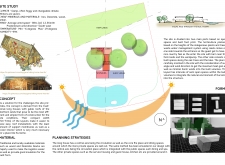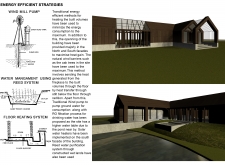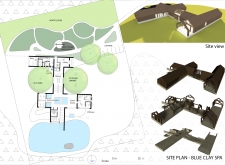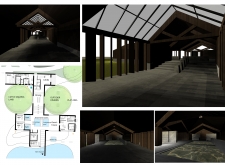5 key facts about this project
At its core, the Blue Clay Spa functions as a sanctuary for relaxation and rejuvenation, emphasizing wellness through careful spatial organization. The building is structured around a central axis, promoting community and social interaction. This axis serves as a backbone, connecting essential public areas such as the kitchen and dining room with private treatment spaces. This structured layout encourages seamless movement throughout the spa, allowing visitors to engage with different areas while maintaining the essential spaces for tranquility.
One of the key design approaches of the Blue Clay Spa is its materiality. The project utilizes locally sourced materials including wood, dolomite, and concrete, which not only enhance the building’s sustainability but also reflect the visual language of the surrounding environment. Wood provides warmth and aesthetic appeal, creating inviting interiors that resonate with the natural landscape. Dolomite, a naturally occurring sedimentary rock, is strategically used for its strength and durability, adding a sense of permanence to the structure. Concrete serves as a reliable material for foundations and structural integrity, especially in spaces that accommodate water features such as pools and baths.
The architectural design of the Blue Clay Spa further emphasizes energy efficiency through the integration of renewable resources and innovative systems. The building incorporates a windmill pump system that harnesses local wind patterns for water management, while a natural filtration system utilizing reeds enhances ecological balance. The installation of solar water heaters on the south-facing facade maximizes sunlight exposure, allowing the building to provide hot water efficiently, thus reducing dependency on conventional energy sources. These strategies reflect a commitment to minimizing the environmental impact while ensuring user comfort.
Landscaping plays an essential role in this architectural endeavor. The project takes advantage of the site's topography, positioning outdoor amenities such as relaxation areas and lush gardens in a way that seamlessly connects visitors with nature. The presence of oak trees serves both as a visual anchor and as natural windbreaks, significantly improving the site’s microclimate and shielding the building from harsh weather.
Unique to the Blue Clay Spa is its considerations for both aesthetics and function. The design effectively integrates public and private spaces, ensuring a balanced atmosphere that cultivates community interaction while allowing for individual reflection and relaxation. The use of traditional architectural forms fused with modern techniques establishes a narrative that honors local heritage while advancing contemporary design ideals.
As you explore the project presentation, consider delving into the architectural plans, architectural sections, and detailed architectural designs that further illustrate the innovative ideas behind the Blue Clay Spa. This project stands as an excellent example of how contextual understanding can shape architecture that is both practical and aesthetically pleasing, offering a model for future designs in similar climates.


























